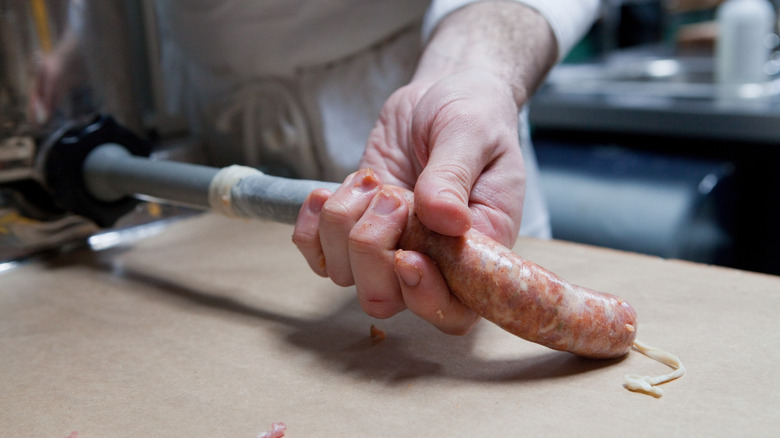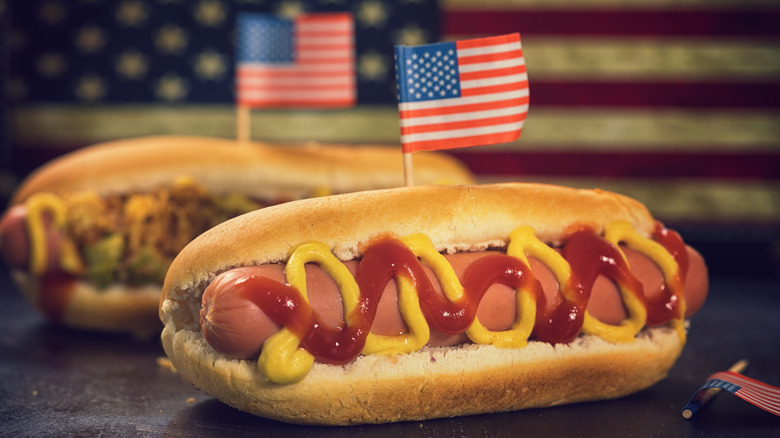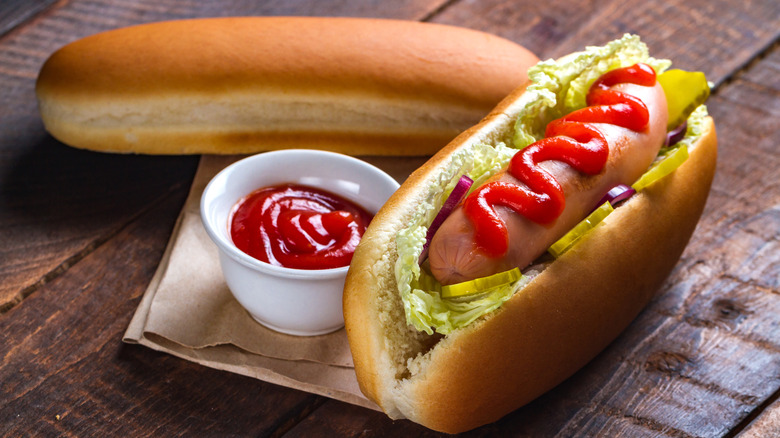Sausages Vs Hot Dogs: What's The Difference
Is there a gastronomical artifact more American than, as the late great Anthony Bourdain liked to say, "meat in tube form"? Sausages, hot dogs, franks, and all manners of encased meats are nearly synonymous with American summers, whether slathered in onions and peppers, destined to bathe in stagnant sidewalk cart water — or, in the case of Chicago, served alongside a veritable salad of toppings.
That is not to say, however, that tubed meats are a uniquely American enterprise. Humans have been stuffing meat and offal into intestinal casings for at least 4,000 years, according to ancient Sumerian texts that detail Mesopotamian cuisine. Just as nearly every civilization has its own kind of dumpling, encased meats, too, have traveled to every corner of the globe. In China, there is the dried lap cheong, which smacks of sweetness thanks to the addition of rose water. The lamb used frequently in North African merguez has a gamey earthiness that stands up to the intense cumin and chilis. And in Central Asia, horse meat-based kazy (and the similar shuzhuk) reign supreme.
So where does the hot dog fit in within the rich tapestry of encased meats? You might remember your middle school math teacher explaining how a square is a rectangle, but a rectangle is not a square. Well, that geometrical logic extends to forcemeat-filled snacks. Hot dogs are a type of sausage — a mixture of protein and seasonings stuffed into a casing — but not the other way around.
Sausage is an umbrella term for an encased meat product
As with most ancient foodstuffs, sausages originated thousands of years ago in the name of preservation. "Sausages were created originally for two reasons," Gary Allen, the author of "Sausages: A Global History," told Atlas Obscura. "One, to make use of every little piece of the meat, so nothing is wasted, and two, by using salt and smoking, it was a way to preserve it." Indeed, "sausage" comes from the Latin word for "salted."
Sausages are simple enough in their construction, but the combination of ingredients is seemingly infinite. Sausages contain forcemeat — the mix of meat and fat also found in pâté, terrine, and rillettes — usually made of poultry, beef, or pork. Seafood and vegan offerings are abundant as well, with the latter consisting of ingredients like soy, pea protein, and coconut oil. The fillings are then zhuzhed up with seasonings and spices, and in some cases, grains like oats or rice. Blood is also a common addition, as seen in blood sausages around the world like black pudding in England and moronga in Mexico.
Sausages can be divided into a few categories. Fresh or raw sausages must be cooked before consuming, since they are neither cured nor smoked, and are typically roasted, grilled, pan-fried, or simmered in beer. You can also buy pre-cooked sausages for easy preparation. In smoked sausages like andouille and kielbasa, the smoke acts as a preservative. Finally, there are air-dried and cured sausages, which may or may not be smoked, like salami and chorizo.
Hot dogs are seasoned and emulsified sausages
When it comes to hot dogs, it is worth asking how the proverbial sausage is made. Hot dogs — also known as frankfurters, wieners, or brats — are made up of meat trimmings, typically beef, pork, or some combination of the two. The trimmings are added to a high-speed machine along with salt, spices, and ice chips, and the ingredients are blended until they form a thick emulsified paste. In the process known as emulsification, two immiscible (or, more plainly, un-mixable) liquids are combined to form a cohesive, homogenous product. Think of a creamy vinaigrette that emulsifies water into fat. Once the hot dog stuff is fully assembled, it is pumped into casings, smoked, and fully cooked.
Hot dogs were brought over by European immigrants to North America, but their origin story is contentious. The city of Frankfurt, Germany claims that the eponymous frankfurter originated there in the 15th century, while another story posits that Johann Georghehner, a butcher from Coburg, Germany, began crafting his "dachshund sausages" in the late 1600s. The Viennese also stake a claim in the beloved meatstuff, citing the term "wiener" and its closeness to "Vienna" as incontrovertible evidence.
Like the content of a hot dog itself, the answer of how the hot dog arrived on American shores is likely a mix, with multiple immigrants bringing the hot dog's forebear to the United States in the 1800s. There, hot dog hubs exploded in New York and Chicago.
There's a wide variety of sausage casings
The tubular shapes and casings are the most prominent visual cues for most kinds of sausages. Some of the more liberated sausages are free from the shackles of casings — think breakfast sausage patties and other freeform shapes. Still, loose sausages are relative outliers, with animal intestine casings persisting as the most traditional and most used form, dating back thousands of years. (Stomachs, as seen in haggis, and appendixes are reliable stand-ins as well.)
There are also synthetic casing options, including those made from inedible cellulose — frequently found around pepperoni and bologna — or edible collagen. Beyond Meat and Impossible Foods wrap their vegan sausages in alginate, a gel made from seaweed, that sizzles and sticks not unlike animal tissue.
According to chef Shaina Loew-Banayan, any malleable wrapper could theoretically work. "In my experience, cooking some sausage meat inside a latex glove makes for a perfect prank," they told Bon Appétit. "There is nothing more unsettling than finding a meat hand in the fridge."
In the case of dried sausages, casings have the unique purpose of acting as the vessels for mold. Indeed, some salami can be seen covered in a white, powdery mold — but don't toss it in the bin just yet. Some producers, such as Olympia Provisions in Oregon, inoculate their salami with penicillium nalgiovense in order to protect it from bad mold and keep it from drying out. Other producers brush off the mold or even apply imitators like rice or milk powder for an old-world finish.
But most hot dogs go au naturale
Unlike other kinds of sausages, you do not want mold on your hot dog casing. In fact, most mass-produced hot dogs don't have casings at all. According to the National Hot Dog and Sausage Council (yes, that is a real thing), most popular hot dog brands in the United States cook their franks in cellulose casing and remove them prior to packaging. Cellulose casings help with ease of manufacturing, since it is easier to transport and hang links than single dogs.
The Council also confirmed that some producers elect to wrap their franks in natural casings, citing a more "traditional" feel, though they tend to be more expensive. Indeed, it is natural casing that lends the delightful and satisfying snap to hot dogs — a textural component that is lost with the use of cellulose. In a blind taste test conducted by Serious Eats, participants' preferences strongly aligned with snappier franks. The snappier the bite, the better the dog.
Even some of the big dogs in the hot dog game, including Nathan's and Sabrett, offer franks with natural casings alongside their respective lineups of skinless hot dogs.
Sausages can have a smooth or coarse texture
Given that sausages are an umbrella term for any sort of encased meat product, they are an endless source of experimentation for chefs, home cooks, and butchers. The preparation of different sausage varieties results in different interior textures. Fresh sausages have a coarse, crumbly texture similar to ground meat. In dried sausages, pockets of meat and fat are visibly separate and have a toothsome chew, while emulsified sausages like bologna and hot dogs have a smooth texture and largely monochromatic interior (mortadella is an example of an emulsified sausage that is not completely homogenous, thanks to big flecks of pork fat and pistachios).
All varieties are linked (pun very much intended), however, in their structure. As sausages are cooked, dried, or fermented, proteins in the meat bond together, creating a cohesive mass that doesn't crumble apart once the casing is broken. Within that framework, any number of proteins can work as the backbone, whether it is popular choices like beef or pork or more exotic outliers like kangaroo or alligator.
Hot dogs have homogenous interiors
While the insides of sausages vary greatly, hot dogs in the United States are manufactured according to federal standards, resulting in a more uniform product. For one, there is the literal uniformity of the hot dogs' interiors. As mentioned, hot dogs are emulsified, resulting in a bouncy texture and homogenous, monochromatic appearance. It is a quality hot dogs share with their blended brethren, chicken nuggets and fish sticks, which have a similarly uniform texture.
According to the U.S. Department of Agriculture, hot dogs cannot contain more than 30% fat or 10% water. Federal regulations also limit the use of non-meat binders and extenders — including dried whole milk, nonfat dried milk, and cereal — to 3.5%. Isolated soy proteins may not surpass 2%.
Any ingredient that is not meat must gain FDA approval prior to manufacturing. These ingredients, like sodium nitrate and celery powder, can aid in the curing process and help give hot dogs their characteristic pink color. Modified food starch, which is made from corn, wheat, or potatoes, give the hot dogs a consistent texture across mass production, while maltodextrin ensures that flavors are distributed evenly. Common seasonings and spices include pepper, garlic, paprika, nutmeg, allspice, coriander, cinnamon, and cumin.
The social history of sausages transcends class
Sausage cookery dates back thousands of years, with different varieties subsequently flourishing in different climates. (In Europe, salami was easy to store in the warm environs of Italy and southern France; fresh sausages like bangers, meanwhile, became a staple in cold-weather England.) But who was doing the cooking? By the Middle Ages, sausage production was a skillset akin to blacksmithing, and it was an accessible trade.
"They were originally very sort of low class because fresh meat was more expensive, richer people would roast large pieces of meat and fresh where poor people would have it preserved and whatever is left over," Gary Allen continued in his same interview with Atlas Obscura. Indeed, the ingredients within sausages were not especially coveted, making them a staple food for low and working class populations. Still, certain sausage varieties required time and craftsmanship afforded only to the wealthy, making the encased meats uniquely capable of transcending class. In 16th century Europe, certain types of sausages and salamis were considered luxurious, urbane snacks. One notable fan of sausages was Queen Victoria. (Perhaps not coincidentally, the monarch suffered from gout.)
Hot dogs: an American immigrant staple
In some ways, the hot dog's ascendance in the United States mirrors its roots across the pond — first as a manifestation of the powers of preservation, then as a working class staple. Unlike their sausage forebears, hot dogs are a uniquely American product of immigration.
The earliest forms of the hot dog arrived in the U.S. in the 19th century, courtesy of European immigrants. German immigrants were known to sell franks from New York City push carts as far back as the 1860s. One, Charles Feltman, began slinging dogs from his push cart in Coney Island in 1867. He sold more than 3,600 hot dogs in his first year of business. Feltman's is still in business today.
In 1893, Chicago hosted the World's Columbian Exposition, where Austrian-Hungarian immigrants Emil Reichel and Samuel Ladany sold their Vienna beef hot dogs for 10 cents a pop. Hot dog proliferation had begun in earnest, and that same year, baseball stadiums began selling the tubed meatstuff as a handy, portable concession. Hot dog fever continued to spike, and in 1916, Nathan Handwerker, a Jewish immigrant from Poland and mentee of Feltman, opened his own hot dog cart. Today, it is still operated as Nathan's Famous.
Much like overseas, hot dogs were a cheap option that was simultaneously embraced by the upper crust, at least as a nod to local cuisine. In 1939, King George VI visited FDR at his Hyde Park mansion, where the pair dined on hot dogs and beer.
To bun or not to bun?
Without the warm embrace of a bun, a hot dog is a pale, vulnerable thing. A sausage on the other hand? That relationship is a little more complicated. Some sausages are right at home in a bun. At ballparks, a hot Italian sausage served in-bun next to peppers and onions is a heartier alternative to a humble hot dog. Other smoked and/or dried offerings would be downright strange ensconced in bread (please do not eat dried chorizo like a hot dog). As ever, context is key.
The closest analog to the hot dog is perhaps the sausage roll — an English analog made of non-emulsified sausage meat and pastry dough. Sausage rolls originated in France in the 19th century, and they became a popular street snack in London during the Napoleonic wars in the early 1800s. A similar treat was developed in Hong Kong, with milk bread serving as the exterior instead of pastry dough.
The history of hot dog buns is hotly contested
No offense to our sausage roll-loving friends in the Commonwealth, but pastry dough does not a hot dog bun make. The hot dog bun's origins are nothing if not contentious. One account credits Polo Grounds concession worker Harry M. Stevens, who, in 1901, ran out of the wax paper in which he served sausages. In a pinch, Stevens pivoted to french rolls.
Another origin story positions necessity as the mother of invention. In 1880s St. Louis, a German hot dog vendor would give his customers gloves with which to handle the franks. Customers would fail to return the gloves, leading the vendor's baker brother-in-law to suggest using a roll instead.
Some hot dog historians deny these accounts, claiming they are too recent to hold water. The oldest one seems to belong to the aforementioned father of Brooklyn hot dogs, Charles Feltman, who is said to have designed his own buns way back in 1867.
The blurry bun history may rile hot dog historians, but for consumers, hot dog buns are infuriating for another reason. Hot dogs are sold in packs of 10, while buns are sold in packs of eight. According to Bruce Kraig, author of "Hot Dog: A Global History," the discrepancy comes down to manufacturing procedure. A typical hot dog weighs 1.6 ounces, so 10 hot dogs equal 1 pound. "If you look at the industrialized systems by which buns are made, they're in trays of four," Kraig explained to KERA. "They're made on conveyor belts, and packages of four work better than any other."
Sausage costs can vary widely
If the social and class history of sausages tells us anything, sausages are pleasing to nearly every palate. But not every sausage is made the same, as indicated by the product's vast price range. Sausage brands like Hillshire and Eckrich tend to rely on fillers, extenders, and mechanically separated animal parts to keep costs down. Smithfield, which is the largest pork producer in the world, uses the cost-effective additive corn syrup as a sweetener. Pumping sausages with additional water and grain fillers also creates the illusion of a plumper sausage, making the product more eye-pleasing to shoppers.
While sausages can serve as an everyman food group, some varieties exist at a higher price point. Factors like production size, time spent curing meats, and using sustainable ingredients can vastly alter cost. "We might not be the cheapest option in the sausage section," Cara Nicoletti, who launched Seemore Meats & Veggies in 2020, told Murray's Cheese Blog, "but our meat is humanely raised." A 12-ounce pack of her vegetable-forward sausages retails for $8.29 at Whole Foods, compared to a 16-ounce package of Premio sausages for $5.19 at Target.
One sausage maker took the food to its logical extreme of luxury. In 2015, British butcher Kevin Turner claimed to have crafted the most expensive sausage in the world at $57 a link. The "posh banger," he explained, was meant for "those sausage connoisseurs with a more discerning taste" (via the New York Post). The luxe sausage contained Mangalitsa pork, truffles, Stilton cheese and a 1947 vintage port.
Hot dogs are a reliable cheap eat
Hot dogs may no longer cost five cents like they did back in 1916, but the tubed meat treat has maintained its reputation of affordability and accessibility. As of this writing, a 10-pack of Oscar Mayer's classic uncured wieners — a medley of chicken, turkey, and pork — sells for $2.84 at Walmart. Springing for an eight-pack of Nathan's all-beef franks will set you back $4.97.
That accessibility often comes at the expense of low-wage workers at meatpacking plants. The industry was hit especially hard during the pandemic, when then-president Donald Trump signed an executive order to keep the plants open at the behest of the Tyson and Smithfield Food CEOs. At that time, hot dog sales rose by 120% as Americans sought out convenient and nostalgic meals. The plants failed to adopt adequate safety measures, and COVID cases skyrocketed.
Indeed, Americans just can't quit hot dogs. In 2015, the World Health Organization reported that sausages are highly carcinogenic. While sales plummeted in the United Kingdom, they stayed consistent in the United States. Even with the scourge of inflation, which had forced hot dog vendors to bump up their prices, hot dog fever hasn't flagged. In 2023, Americans bought 896 million pounds of hot dogs at retail locations, totaling $2.99 billion in sales.
If any institution represents the American hot dog obsession, it isn't Major League Baseball, nor Nathan's famous Hot Dog Eating Contest. It's Costco, which has refused to raise the price of its $1.50 hot dog and soda combo since the deal began in 1985.













